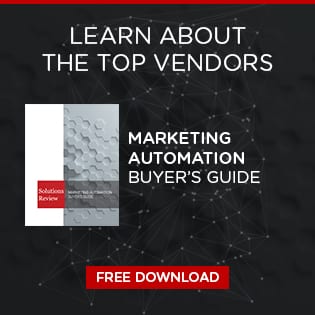An Example AI Readiness Assessment Framework for Marketers

To help companies remain competitive amidst changing markets, the Solutions Review editors have outlined an example AI readiness assessment framework for marketers to use as they work toward AI adoption.
It doesn’t take an expert to see that the marketing industry is at a turning point (and has been for some time). Marketing has always been an agile business, but artificial intelligence has put the pedal to the metal, accelerating innovative new technologies, strategies, and working methods that can be challenging for even the most veteran professionals to keep up with. One thing is clear, though: AI adoption is a non-negotiable. The key is identifying where you are in the adoption pipeline and charting a path that places you (and your brand) ahead of the curve.
It’s not enough for a company to say it’s adopting AI. Real, valuable success will come to the organizations that conduct rigorous readiness assessments before implementation, as those that rush into AI deployment risk wasting resources and damaging customer relationships. With that in mind, we’ve compiled an example framework marketers and marketing firms can use to assess their AI readiness. This assessment will examine the depth of leadership commitment, the clarity of AI-driven marketing goals, and the integration between AI and overall marketing strategy.
Strategic Alignment Assessment
The foundation of AI readiness begins with strategic coherence. Marketing organizations must first evaluate whether their AI initiatives align with broader business objectives and customer value propositions. To that end, leadership commitment needs to extend beyond budget allocation to include philosophical alignment with data-driven decision-making. Organizations should assess whether executives understand AI’s transformative potential rather than viewing it as a tactical efficiency tool, as the most successful implementations occur when leadership recognizes AI as a fundamental shift in how marketing creates and delivers value rather than merely an automation layer.
Strategic goal clarity also requires measurable outcomes tied to customer lifetime value, acquisition costs, or revenue attribution. Vague objectives like “improve personalization” or “enhance customer experience” can indicate insufficient strategic preparation and won’t help anyone find success. Mature organizations will identify and articulate precise metrics for success. These can include reducing customer acquisition costs by specific percentages, increasing cross-sell rates within defined timeframes, or something else entirely. Specificity is the secret ingredient needed.
An ideal AI readiness assessment evaluates how AI initiatives connect with existing marketing strategies, brand positioning, and customer journey design.
Data Infrastructure Maturity
Data infrastructure represents another critical success factor for marketing AI implementations. This phase of assessment evaluates data quality, accessibility, governance, and scalability across customer touchpoints. A data quality assessment encompasses accuracy, completeness, consistency, and timeliness across all customer data sources. As such, marketing organizations should measure data decay rates, identify gaps that prevent comprehensive customer profiling, and evaluate the reliability of attribution data.
These evaluations examine how quickly marketing teams can access and utilize customer data for AI-driven campaigns. This includes API responsiveness, data warehouse query performance, and the availability of real-time data streams. Organizations with slower data access typically struggle with AI applications that require rapid decision-making or real-time personalization. Another avenue to take is scalability evaluation, which examines whether the current data infrastructure can support increased AI workloads without performance degradation. Organizations that underestimate infrastructure scaling needs often face significant cost overruns and performance issues during AI deployment.
Technical Capability Evaluation
Technical readiness encompasses the organization’s ability to implement, maintain, and evolve AI systems for marketing applications. As you can imagine, this is a pretty important area to assess, as it covers internal technical expertise, technology stack compatibility, and integration capabilities with existing marketing tools. One way to start is with an internal expertise assessment that examines the depth of AI and machine learning knowledge within the marketing organization and supporting IT teams.
By evaluating data scientists’ experience with marketing applications, marketing technologists’ understanding of AI capabilities, and the general marketing staff’s comfort with AI-driven tools, organizations can develop and deploy an AI strategy that meets their needs and accommodates their skill levels. That’s the key to an empathetic AI framework, which can fundamentally improve how easily your employees adapt to the AI ecosystem.
A technology capability evaluation should also look outward. For example, vendor evaluation processes represent another critical technical capability to investigate. This means organizations must assess their ability to evaluate AI vendors, negotiate appropriate service levels, and manage vendor relationships over time.
Organizational Change Readiness
Successful AI implementation requires significant organizational adaptation across marketing teams. These assessments focus on the big picture by evaluating an organization’s change management capabilities, skill development programs, and cultural readiness for AI adoption. Change management maturity examines the organization’s track record with technology adoption, communication strategies for AI implementation, and processes for managing resistance to change. Organizations with poor change management capabilities often face significant internal resistance that undermines AI project success.
Skill development assessments are another avenue, encompassing existing training programs and learning and development budgets to measure a company’s commitment to upskilling marketing professionals. AI implementation requires new skills across multiple roles, from campaign managers who need to understand AI recommendations to creative teams who must work with AI-generated content variations. Knowing what skills your team has (or doesn’t have) will make the implementation process go far smoother.
Skills don’t stop with the technical, though. Teams must also evaluate their cultural readiness for AI. That involves examining a marketing team’s openness to data-driven decision making, comfort with algorithmic recommendations, and willingness to experiment with new approaches.
Regulatory and Ethical Compliance Framework
Marketing AI implementation must also navigate complex regulatory requirements and ethical considerations that continue to evolve rapidly. While companies can do this without a formal board of experts, it’s recommended that they create an internal AI ethics review board. The team will track compliance readiness, ethical frameworks, and risk management capabilities.
At a procedural level, the board is responsible for reviewing high-impact AI systems before deployment to ensure they undergo rigorous impact assessments, fairness testing, and documentation of purpose and scope. Members will also approve, delay, or reject use cases based on ethical criteria, and could be tasked with reviewing third-party vendor systems for alignment with the organization’s standards.
Prioritizing an AI Ethics Review Board (AIERB) will help a company improve its brand. AI might be commonplace in business, but the general populace can still distrust the technology. When you have an AIERB creating ethical frameworks for AI implementation, your company will streamline its internal adoption of the technology and show the outside world that you’re taking it seriously, respecting your existing workforce, and pursuing a balance between progress and stability. Failing to do so can do irreparable damage to a brand, just like what happened to Duolingo.
Another route is risk management assessments. By evaluating an organization’s ability to identify, monitor, and mitigate risks associated with AI-driven marketing activities, a company can design a system for continuously monitoring emotional sentiment, cultural alignment, and relationship quality metrics that traditional risk systems ignore entirely. This includes assessing processes for detecting AI model drift, managing bias in targeting algorithms, and responding to customer complaints about AI-driven experiences.
Implementation Sequencing Strategy
The final avenue evaluates the organization’s approach to AI implementation sequencing, pilot program design, and scaling strategies. Successful AI adoption requires thoughtful phasing that builds capability incrementally while delivering measurable business value, which this phase puts front and center.
Pilot program assessment examines the organization’s ability to design controlled AI experiments that generate meaningful learning while minimizing business risk. While setting up a pilot program can feel time-consuming, the benefits will pay off. For starters, companies that lack rigorous pilot methodologies often make scaling decisions based on insufficient data, leading to failed large-scale implementations. The cost of those failures will far outweigh the time and money invested in a pilot program.
Ultimately, a successful measurement framework assessment evaluates how a marketing team will measure AI implementation success and make adjustments. Those who focus on these will equip themselves with the metrics they need to invest in projects with the highest degree of internal and external success.
Assessment Scoring and Interpretation
Following through with the assessments above is essential, but companies must also devise a way to understand what those assessments yield. The most straightforward approach is to score each category on a five-point scale reflecting current capability maturity. For example, any area scoring below three should address those gaps before proceeding with the marketing AI implementation. Meanwhile, those scoring four or above in all dimensions are prepared for aggressive AI adoption with appropriate risk management.
These assessments aim to reveal interdependencies between dimensions that require coordinated development. Organizations cannot compensate for weak data infrastructure with strong technical capabilities, for instance, nor can excellent strategic alignment overcome poor departmental change readiness. Successful AI implementation requires balanced capability development across all assessment dimensions.
Regular reassessments will also become critical as AI technologies evolve and organizational capabilities mature, which they undoubtedly will. Each framework should be applied quarterly during active AI implementation and annually for ongoing capability maintenance to ensure organizations maintain readiness for emerging AI opportunities while addressing capability gaps before they become implementation barriers. Marketing teams and organizations that conduct thorough assessments and address identified gaps will position themselves to capture AI’s transformative value while avoiding common implementation pitfalls that plague unprepared organizations.





















